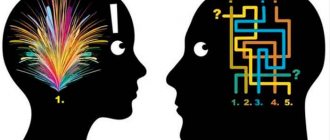What is psychosophy
Psychosophy (or psychoyoga) is a theory of personality proposed by A. Yu. Afanasyev in the book “Syntax of Love”.
In it, the author proposes to divide people into 24 types. Each type has certain characteristics and, according to a certain logic, interacts with other types, society, and has certain habits and predispositions. Thus, having determined one of the 24 types to which a person belongs, you can give recommendations on what to do in life, which people should be avoided and which ones should be trusted, which aspects of oneself should be developed, etc. This theory is little known. And, unfortunately, information in its pure form is difficult to find except for the original book, of course. Many practitioners you meet see psychosophy as a subset of Jung's personality theory (socionics) and therefore mix both theories. Nevertheless, Afanasyev did not mention anything about socionics and Jung in his book, and his theory is positioned as something separate, integral, closed and independent. It is in this form that I will try to present psychosophy here. My goal is to describe the basic principles of psychosophy for people who have not heard anything about it. I will omit complex and optional elements and terms.
ESE “Hugo”
Writers: Victor Hugo.
Actors, showmen, singers: Nikolai Fomenko; Elena Malysheva (LFEV); Ani Lorak (VEFL); Evgeny Kolesov; Lolita Milyavskaya (EFLV).
Politicians: George Washington.
Businessmen: Evgeny Chichvarkin (VFEL).
Characters from books and films: Aramis; Julia Child (film Julie and Julia: Recipe for Happiness); Lee Ann Twohey (film The Blind Side); Kelly (Black Mirror: San Junipero).
Basic theory: 4 functions
The foundation of the theory is 4 functions: logic, will, emotion and physics. Their names are usually shortened to the first letter, making it capital, which I will stick to. For example, V means will, and L means logic. It is assumed that these functions are present in every person, but within each they have different strengths, forming a sequence. This sequence is called a personality type, for example, the EFVL personality type means that internally a person feels that he has the strongest function of emotion, followed by physics, then will and finally logic. It can be counted that there are a total of 24 different permutations of functions, so there are 24 personality types.
Now a little more about the functions.
E
- function of emotion. This is rather not the level of a person’s emotionality, but rather several and how a person is used to perceiving his own and other people’s emotions.
L
- function of logic. In no case should you think that this is the level of intelligence, IQ, erudition. This is a person’s attitude to logical structures, how much and how a person is used to using it and appreciating it in other people.
F
- a function of physics. The same as logic and emotion, but in relation to the material. This includes money, body, social status, sports, etc.
IN
- function of the will. This is probably the most difficult function to describe. Try to find a common grain in the concepts of “responsibility,” “control,” and “fairness.” Something common to all three concepts is will in the understanding of psychosophy. And of course, as with other functions, will is not at all the level of willpower, but a person’s attitude to the areas of life that are affected by the volitional aspect.
About the position of a function in a type.
1
- This is a strong function prone to selfishness. A person tends to identify himself with her. In relation to this function, a person is as unyielding and self-confident as possible.
2
is a strong and flexible function directed to the outside world. Inclined in dialogue with other people, the best understanding is achieved through this function. A person tends to use it as a tool to achieve goals.
3
- a weak function that really wants to seem strong, which makes it painful. He feels the world very well, has great ambitions, but sometimes something is missing to be fully realized. Poor ability to place the importance of shades.
4
- a weak and quiet function that a person is accustomed to underestimating and not using in most situations, nevertheless, working on this function is a pleasure.
The location of values in the system of psychosophy
Now let's talk about what location of value means. How the First, Second, Third and Fourth functions behave.
1 The function is self-sufficient and selfish in its knowledge; Afanasyev claims that it is a gift to oneself. She exists only for herself. All its manifestations from the outside look somewhat exaggerated. This is something that exists in abundance. And that is precisely why there is a certain need from time to time to put this excess somewhere. Function 1 splashes it out into the world around her, but the co-process is not important to her, and communication with her becomes for those around her like those scraps from a master’s table. Which you not only must accept, but you must also tearfully thank her for the fact that she was honored to condescend to you, the orphaned and wretched. This is a case of feeling complete superiority over others when you are on her territory and she is better than you in any case.
2 The function exists both for itself and for people. Work on it is carried out constantly, continuously improving any achieved result. 2 The function is developed in the personality very harmoniously. The energy allocated to her is just right, and therefore to those around her she seems like a gift from heaven, contact with her is most comfortable. Communication occurs on the same level. She is ready to listen to you and will not refuse to share her existing information and best practices. It is the most liberal and democratic. A continuous process and contact with the world is important to her. She is ready to teach him and learn from him. This feature is a gift to the world.
3 Function is such a nasty thing, ingrained in every person that it not only poisons his entire existence, but sometimes also begins to undermine the basis of personality (if the third is Will , this may be the case). This function is a sore subject, a place of greatest uncertainty. We want something about it, but we don’t know how to achieve it, whether this desire is legitimate and whether we really want it. But uncertainty regarding this function pushes us towards self-development. I want to doubt less, I want to be more proud of myself for it, I want to be recognized for it. Ideally, progress in this function will become complete self-realization.
4th function - something whose meaning is so leveled that when it is good, well, if not, then it’s not a problem either. 4 The function is not critical, it does little and, in principle, will “devour” any product offered to it from the outside, and will even thank you for relieving it of responsibility for solving the problem. She does something on her own, without outside help, but even she doesn’t really know what she’s doing. Its main distinguishing feature is the ability to adapt to any conditions, as long as they do not contradict higher values, and to honor the charter of any monastery.
Types
To understand what a specific type is, it is enough to use what is written above, namely, to connect the meaning of each function with its position in the type. For example, we have an EFVL type: emotion comes first (1E), then 2F, 3B and 4L. This means that such a person is emotional, lives by emotions, which are very vivid and contagious to others. 2F makes him an active person who loves a variety of physical sensations, is well versed in food, beauty, tastes, is attentive to others, and constantly pays attention to how physically comfortable a person is. 3B means that social fulfillment and respect from others are very important for a person; insults are painfully perceived. 4L - this means that a person is not inclined to build complex logical schemes and theories about everything around him, and is also not inclined to listen to them, in other words, even if everything is told and explained to him logically, he will still do it his own way.
What was described above is just a small and far from complete example of how to build a type description yourself, based on the sequence of functions. (you can also see my type descriptions at this link: ...)
Logic, Physics, Will, Emotion
Logics, Physics, Wills, Emotions actually represent . Otherwise, confusion will begin among us, and we will declare some kind of Will as Logic. In short, without really understanding what is what, we will introduce the wrong value that we are talking about.
Logic represents everything that is under the jurisdiction of reason alone. This is something rational, orderly, capable of clearly, or for some not clearly, depending on the importance of this function for a particular person, the formulation of thoughts. She is responsible for the meaning and content of speech, and is responsible for ideas. You will be able to express yourself and understand what those around you want to convey to you, with her help. It structures and organizes information already received from the world. She makes observations and notes inconsistencies. She can systematize and generalize. Her introduction is constructive. She is capable of discussion. And from the point of view of how important this is for the Logic of each individual person, how well it turns out, how much pleasure it gives you and me, we can judge the location of value relative to others.
Physics is the material world, the body, sensory information. Its position speaks about how important material realization is to us: money, health, beauty, physical activity in the form of sports, sensations when contacting the world. Can we, if something happens, give up all this, abandon it, or is Physics the first thing for us (let's do without anything else!)?
Will is the strength of spirit, the goal and its achievement. This is what we use when making choices at the crossroads of fate. It is its location that indicates the self-sufficiency and self-control of the individual. It determines justice and the share of responsibility that a person is ready to take upon himself. How important status is for an individual, his authority and the question of influence are also determined by the position of the Will .
And finally, Emotion. Are you able to accurately understand your feelings? Are you excited? Relaxed? What do you feel? Do you like? Do you hate it? Do you understand what friendship is and are you capable of such an attitude? How easy is it for you? Do you need it? Aren't you afraid of him? How good are you at interpersonal relationships? Do you understand which emotions are related, and which can accompany each other, and which can flow and change, becoming something else. How easy is it for you to communicate? Do you need an emotional interlocutor? Do you like speaking in public? Do you understand what morality is? How do you feel about art? Do you believe in God and otherworldly forces?
How to type
Having become acquainted with personality typology, a reasonable question arises: how exactly can you find out the type (type) of a particular person? Here I would highlight 4 methods:
Observation
behind a person and identifying features that exclude certain options for the arrangement of functions until the type becomes clear. For example, you know that a person likes to build theories and prove something or tell others, this is almost guaranteed to exclude 4L. If a person does not stand out for his special romanticism and great vividness of emotions, then this is not 1E, and if it seems that the person shows himself weakly emotionally, then he is not 2E. In this way, step by step, you can find out the entire type of person.
Typing by dichotomies.
The following dichotomies for functions are distinguished:
- strong (1 and 2) – weak (3 and 4)
- productive (1 and 4) – processional (2 and 3)
- dominant (1 and 3) – adaptable (2 and 4)
In a strong function a person is always confident in himself, while in a weak function there is always an element of uncertainty. The productive function is not inclined to dialogue, but rather to a monologue and a speedy completion, while the processive function, on the contrary, is interested in acting and trying different options. The dominant one is often the reason to act (confidently or uncertainly), she has a lot of ambitions, and the adapter calmly accepts everything. Based on a person’s behavior, one can often notice certain dichotomies, which is very helpful in typing.
Partial typing.
Sometimes you need to type quickly, even if not completely. For example, you see a person who clearly shows that he has 1B. This already means that he does not have 1L, not 1F and not 1E. Also from this, for example, it may follow that if you do not have a 3B, then most likely there will not be an acute conflict with him, and if you have a 3B, then you need to be on the outside, because some of his actions may seem too harsh and unpleasant for him. you.
Test.
For typing you can use the test.
LII “Robespierre”
Scientists: Rene Descartes; Immanuel Kant; Arthur Eddington; Alan Turing.
Actors, showmen, singers: Nikolai Drozdov (LEVF); Alexander Gordon (VLEF); Ivan Usovich (FEVL).
Writers: Ayn Rand (VLFE).
Politicians: Maximilien Robespierre (VLEF).
Businessmen: Mikhail Khodorkovsky (LVEF); Warren Buffett.
Characters from books and films: Athos; Daniel Jackson (LEVF) (Stargate movie); Michael Scofield (VLEF) (film Prison Break).
Relationships
Psychosophy easily and logically predicts the relationships between types. The relationships are looked at for each function separately, for example, there are two types EFVL and VEFL. In terms of emotions they have relationships according to the scheme 1-2 (the first with the second), in physics - 2-3, in terms of will - 1-3 and in logic 4-4. Based on the meaning, all possible types of connections can be classified into 4 groups:
Additions (1-4, 2-3).
The strengths of one function naturally cover the weaknesses of another. This is the best combination.
Identical (1-1, 2-2, 3-3, 4-4).
They are characterized by good mutual understanding, and for strong functions, also mutual respect. But the addition does not occur.
Pseudoidentical (1-2, 3-4).
There is no good mutual understanding. People seem to be similar, but the goals of some are the means of others, which makes them fundamentally different. This is a source of misunderstanding in some cases, but not a source of conflict.
Conflict (1-3, 2-4).
There is a deep misunderstanding between these functions, which can even result in conflicts. Only because of this combination of functions can underestimation of a person appear, disrespect for him and his actions.
Already based on this description, it is clear that for each type there is a type with the best and worst relationships. For example, for the EFVL type, the best is LVFE, and the worst is VLEF. Although in theory everything is smooth and logical, in life a lot also depends on a person’s upbringing, the ability to hear other people and value trust. It seems to me from my experience that education, the ability to hear, trust are all psychosophy and can be either present or absent in each type.
ILE “Don Quixote”
Scientists: Albert Einstein (LVEF); Sigmund Freud (VLEF); Karl Marx; Nikola Tesla; Grigory Perelman.
Actors, showmen, singers: Vadim Galygin; Dog Korolenko; Ivan “Noize MC” Alekseev (VBLHEP).
Politicians: Ksenia Sobchak (LVFE).
Businessmen: Steve Jobs (VLEF); Elon Musk.
Characters from books and films: D'Artagnan; Doctor House (VLEF) (s/s Doctor House); Doctor Who (film Doctor Who), Dr. Emmett Brown (film Back to the Future), Dr. Rodney McKay (film Stargate: Atlantis) (LVFE), Ben (film Captain Fantastic) (FLVE).
[edit] Type table
| Name | 1 | 2 | 3 | 4 |
| Tolstoy | Will | Emotion | Physics | Logics |
| Socrates | Will | Logics | Emotion | Physics |
| Akhmatova | Will | Emotion | Logics | Physics |
| Tvardovsky | Will | Physics | Emotion | Logics |
| Napoleon | Will | Physics | Logics | Emotion |
| Lenin | Will | Logics | Physics | Emotion |
| Aristippus | Physics | Logics | Will | Emotion |
| Chekhov | Physics | Will | Emotion | Logics |
| Dumas | Physics | Emotion | Will | Logics |
| Epicurus | Physics | Logics | Emotion | Will |
| Borgia | Physics | Emotion | Logics | Will |
| Goethe | Physics | Will | Logics | Emotion |
| Bukharin | Emotion | Physics | Logics | Will |
| Andersen | Emotion | Logics | Will | Physics |
| Ghazali | Emotion | Will | Logics | Physics |
| Parsnip | Emotion | Will | Physics | Logics |
| Rousseau | Emotion | Logics | Physics | Will |
| Pushkin | Emotion | Physics | Will | Logics |
| Berthier | Logics | Physics | Emotion | Will |
| Pascal | Logics | Emotion | Will | Physics |
| Plato | Logics | Physics | Will | Emotion |
| Einstein | Logics | Will | Emotion | Physics |
| Augustine | Logics | Emotion | Physics | Will |
| Lao Tzu | Logics | Will | Physics | Emotion |
[edit] Links
- “Syntax of Love” by Alexander Afanasyev (original source)
- Functional settings in Psycho-yoga, description of types
- The difference between psychosophy and socionics, explanations for the article “Functional settings in psyche yoga”
- about psychosophy on the website of the Faculty of Psychological and Pedagogical Management of the Higher School of Social and Management Consulting
- Simple Typing Method: Listing Priorities
- The origin of psychosophy as a system
- Psihosofiya.ru Popular about psychosophy. Description of types. Intertype relationships. The connection between psychosophy and socionics. Determining the comfort of relationships taking into account socionics and psychosophy.
- Article “Psychosophy from the point of view of a systems approach” - a description of the PS model based on the principle of negative feedback
- Sociomodel.Ru - a brief summary of the basics of psychosophy for beginners. Description of the mutual influence of socionic and psychosophical types.
- Official website of the scientific and creative heritage fund of Alexander Yuryevich Afanasyev.
- 5th edition of the book “Syntax of Love” by Afanasyev A.Yu.
- 16-component model of psychosophy
IEE “Huxley”
Actors, showmen, singers: Mikhail Zadornov; Efim Shifrin; Mikhail Boyarsky; Tatyana Lazareva; Alexey “Guf” Dolmatov (FVLE); Sergey Svetlakov (LVEF); Yulia Menshova (ELFV); Aglaya Tarasova, Valery Komissarov (LEVF).
Writers: Thomas Huxley; Alexander Pushkin (EFVL); Dale Carnegie; Mark Twain.
Athletes: Ilya Kovalchuk (FVEL).
Characters from books and films: Tom Sawyer; Dirk Gently (s/s Dirk Gently Detective Agency).
Isaev Yuri Vladimirovich
Interaction of functions in psychosophy A.Yu.Afanasyev. Analysis of the comfort level of interaction.
Key words: psychosophy, psycho-yoga, A.Yu. Afanasyev, relationships, interactions, functions
This article will present a method for assessing the level of comfort in couple relationships, based on the psychosophy of A.Yu. Afanasyev [1]. The method is built on the principle of analyzing the interactions of functions separately and calculating the total characteristic.
When analyzing the interaction between two functions, only those pairs of functions are taken that process the same area (Will, Physics, Logic or Emotion).
A.Yu. Afanasyev in his work “Syntax of Love” [1] described the following properties of functions:
Processivity-Efficiency
Dialogue-Monologue
And also described the functions themselves.
Based on the descriptions and properties of functions presented by A.Yu. Afanasyev [1], it is possible to theoretically describe the interaction between these functions.
Interaction 1 - 1 (Comprehension)
The first two functions see and understand each other's strength, as well as the motivation and motivation for using this force. Both functions are monologue and result-oriented, so each one analyzes the other inwardly and comes to the conclusion of how to divide the sphere of influence. As such, there is no struggle, except perhaps a fleeting division of spheres of influence, after which each function deals with its own “territory” while showing respect for the “territory” of the other.
This interaction can be assessed as neutral.
Interaction 1 - 2 (Suppression)
The first function is monologue and focused on the result, while the second function is interactive and focused on the process. The second function, when tasks from its area appear, starts a dialogue and wants to enjoy the joint process of solving this problem, but instead of supporting the dialogue, it encounters the power of the first function aimed at achieving a result as quickly as possible. Ignoring attempts to start a dialogue and a rather rude statement of the point causes the second function to become confused, and later upset by the fact that the best qualities sent by the second function for support are simply not needed, the first is quite sufficient on its own. Nevertheless, the second function continues over and over again to try to start a dialogue when new tasks appear.
This interaction can be assessed as uncomfortable. The first function perceives the second as an obstacle to achieving a result, the second perceives the first as a dictator who refuses to cooperate.
Interaction 1 - 3 (Suppression)
The situation is similar to the previous one (1-2), with the only difference being that the third function does not have the power inherent in the second function. At first, the strength and confidence of the first function attracts the third, which hopes for support in joint problem solving, but later faces the fact that the first function does not imply a joint process at all, but confronts it with the fact of the decision it has made. On the one hand, such interaction puts pressure on the third function, on the other hand, it causes competition in the third function and a desire to surpass the first function. For the first function, such interaction is also twofold, since the third function, which does not strongly resist the dictates, can at one moment rebel and, out of principle, take the oppositional side.
This interaction can be assessed as uncomfortable. The third function feels suppressed and sooner or later starts a “revolution” that threatens a serious conflict. The first function may be seriously deceived by the initial loyalty and admiration of the third function.
Interaction 1 - 4 (Support)
Both functions are monologue and result-oriented. At the same time, the fourth function is not very interested in solving problems that fall within its area, and gladly dumps them on the first, which in turn calmly solves them. The dictate of the first function is perceived normally, as an opportunity to shift responsibility for solving a problem to someone else. The first function sees the fourth as a loyal vassal who, without unnecessary disputes, accepts the result of the work of the first function.
This interaction can be assessed as comfortable. The first function takes “under the wing” of the fourth, which, in principle, is happy about. The first function realizes its abundant power, and the fourth does not need to expend its already meager reserves.
Interaction 2 - 2 (Comprehension)
Both functions are conversational, process-oriented, and powerful. When faced with a problem, they willingly begin a joint solution process; the only drawback is the fact that each, for its part, is ready to provide support, while both do not need it.
This interaction can be assessed as neutral. On the one hand, the functions interact well and jointly solve problems, on the other hand, each of them feels insufficiently in demand due to the lack of need for the help and support that it is ready to provide.
Interaction 2 - 3 (Support)
Both functions are interactive, configured for the process, as in the previous case (2-2). In this embodiment, the desire of the second function to provide support is met with a request for support from the third function.
This interaction can be assessed as comfortable. Both functions are implemented in dialogue with each other, while the third function receives support for solving complex problems, and the second feels in demand.
Interaction 2 - 4 (Ignore)
The second function is conversational and process-oriented, while the fourth function is monologue and result-oriented. When a task arrives, the second function initiates a dialogue, wanting to realize itself in the process of solving the problem, giving support. The fourth ignores attempts to call her to dialogue and simply shifts the task to the second function, which is perceived by the second function as a rather harsh form of refusal. While the fourth function perceives the second as an annoying interlocutor on a topic that the fourth is simply not interested in, the second function feels rejected and unclaimed.
This interaction can be assessed as uncomfortable. The fourth function is not interested in the topics raised by the second function, which is why the second function cannot realize itself fully.
Interaction 3 - 3 (Comprehension)
Both functions are interactive and process-oriented, so when faced with a problem they are happy to begin a joint solution process. Moreover, each function expects support from its partner in the event of encountering difficulties that the partner is unable to provide. However, the partner's failure to provide significant support is accepted with understanding.
This interaction can be assessed as neutral. Solving problems together is a pleasure, but it is difficult for partners to cope with serious difficulties, since both in this case require support that they are not able to provide.
Interaction 3 - 4 (Ignore)
The situation as a whole resembles the interaction of the second and fourth functions, with the difference that the third function expects support and dialogue, and the fourth function shifts the solution of the problem to the third and waits for it to be provided with a finished result.
This interaction can be assessed as uncomfortable. The request for dialogue and support of the third function does not receive a response, at the same time, the fourth function does not feel sufficient reliability in the third to transfer responsibility to it.
Interaction 4 - 4 (Comprehension)
Both functions are monologue, focused on results and not interested in the tasks of their field. The incoming task is ignored, responsibility for its solution is transferred to each other until the task is resolved from the outside or one of the partners overcomes himself and resolves it. At the same time, such a situation is perceived by both with understanding.
This interaction can be assessed as neutral. Both functions are not interested in incoming tasks and understand each other’s reluctance to deal with them, often leaving the solution to chance.
Based on the interactions described above, it is possible to analyze any combination of relationships between all 24 types in psychosophy. For example, consider the following situation:
First partner: 1 Will, 2 Physics, 3 Logic, 4 Emotion
Second partner: 1 Logic, 2 Will, 3 Physics, 4 Emotion
In these relationships the following interactions can be traced:
Will 1-2 (Suppression) - The first partner takes responsibility for tasks associated with will, prefers to make decisions independently and offer results. At the same time, sometimes he expects a clear “yes/no” answer, based on which the decision will be approved and implemented or rejected. The second partner, still wanting to initiate a dialogue about the decision being made, can, instead of approving or rejecting the results of the work of the first partner’s function, start a process of discussion and persuasion. Such a process is perceived by the first partner as a waste of time and effort, and therefore is interrupted by an effort of will, which is perceived as dictate.
Logic 1-3 (Suppression) - The second partner takes responsibility for tasks that require mental activity, prefers to think about them independently and provide only the result of his thoughts. The first partner wants to see the train of thought, how exactly such a solution was developed, and generally participate in solving the problem. Over time, the initial admiration of the first partner for the thoughtfulness of the second develops into a desire to win, overcome, and palm off such a task so that the second partner begins to “think out loud” and allows him to participate in this process.
Physics 2-3 (Support) - Both partners are committed to dialogue in matters of physical interaction (active recreation, sports, work, etc.), while some self-doubt in the second partner’s abilities is compensated by the support of the first.
Emotion 4-4 (Understanding) - Both partners are unwilling to address issues related to emotions. And they understand each other in this.
To analyze the comfort level of interaction, we apply the following method:
For each comfortable interaction, 1 point is added to the score.
For each uncomfortable interaction, 1 point is deducted.
Neutral interactions do not affect the rating.
Thus, we obtain the following interaction evaluation table:
Interaction
| Description | Grade | |
| 1-1 | Understanding | 0 |
| 1-2 | Suppression | -1 |
| 1-3 | Suppression | -1 |
| 1-4 | Support | +1 |
| 2-2 | Understanding | 0 |
| 2-3 | Support | +1 |
| 2-4 | Ignoring | -1 |
| 3-3 | Understanding | 0 |
| 3-4 | Ignoring | -1 |
| 4-4 | Understanding | 0 |
Since the number of interactions between any two types according to psychosophy will be equal to four (according to Will, Physics, Logic and Emotion), then:
— the most comfortable relationship will have a score of +4 points;
— the most uncomfortable relationship will have a score of -4 points.
It is also worth considering the point that when searching through all possible options for relationships, due to the dependence of the location of the functions relative to each other, it is impossible to build relationships in which the total score will be equal to +3 or -3 points.
Accordingly, the following table can be compiled:
| Grade | Comfort level |
| +4 | Comfortable |
| +2 | Moderately comfortable |
| +1 | Neutral-comfortable |
| 0 | Neutral |
| -1 | Neutral-discomfortable |
| -2 | Moderately uncomfortable |
| -4 | Uncomfortable |
Note that the relations described by A.Yu. Afanasyev [1] using this method receive the following estimates:
| Relationship | Grade |
| Full Eros | -4 |
| Full Philia | 0 |
| Complete Agape | +4 |
The relations specified in the example, according to this method, will have the following evaluation:
| Interaction | Grade |
| Will 1-2 (Suppression) | -1 |
| Logic 1-3 (Suppression) | -1 |
| Physics 2-3 (Support) | +1 |
| Emotion 4-4 (Understanding) | 0 |
| RESULT: | -1 |
A score of -1 on a scale of -4 to +4 can be described as a neutral-discomfort level relationship.
This article presented a method for analyzing the level of comfort in relationships, based on the psychosophy of A.Yu. Afanasyev. This method can be used in assessing and predicting both personal and business relationships.
11.03.2008
List of used literature:
1. A.Yu. Afanasiev.
Syntax of Love. Personality typology and forecast of pair relationships, M.: Chernaya squirrel, 2007. - 352 p.
Social commentary Cackle
[edit] Branch hypotheses, further development of the theory
1. It is assumed that the completeness of the set of functions ( Will, Logic, Emotion, Physics
) is ensured by the fact that
- The will is “responsible for” irrational information about external (for humans) reality
- Logic - for rational information about external reality
- Emotion - for rational information about internal reality
- Physics - for irrational information about internal reality
Here, irrational information is information that has not been processed by consciousness (≈ quantitative information - the results of measurements of any quantities), and rational information is information that has been processed by consciousness (≈ qualitative information - signs or symbols in some symbolic system).
2. It is assumed that the properties of the functions described in the paragraph “The main phenomenon studied in modern psychosophy” are explained by the fact that
- The 1st function influences the other three functions actively both in form and in essence of manifestations: it transmits significantly more/more often information and energy to the other three functions than it receives from them
- The 2nd function transmits somewhat more than it perceives; active in essence, adaptive in form
- The 3rd function noticeably perceives more than it transmits; adaptive in essence, active in form
- The 4th function influences the other three functions adaptively both in essence and in the form of manifestations: it receives significantly more/more often information and energy from the other three functions than it transmits to them
3. 16-component model
According to this model, each psychosophical function has 4 components for assessing its manifestations (also called areas of manifestation): assessment for achieving a goal/result (G) assessment for changes in approach to the goal/result (s) assessment for changes in resources (Mick called this a gradient by resources) (m) estimate by resources (R)
[edit] Introduction
According to the teachings of A. Yu. Afanasyev, a person’s personality can be divided into four components - modules of the psyche - Physics, Logic, Emotion and Will. These concepts are based on the ideas accumulated by humanity about the “body”, “mind”, “soul” and “spirit”, respectively, with the difference that we are not talking about the actual filling of these ideas, but about an inseparable part of the human psyche that gives birth to these representation.
The set of types of Psychosophy is formed by rearranging all the modules, and the names of historical figures - prominent representatives of these types - are taken as names.
Tables of intertype relationships
...or choose your socionic type:
Don Quixote Dumas Hugo Robespierre
Hamlet Maxim Zhukov Yesenin
Napoleon Balzac Jack Dreiser
Stirlitz Dostoevsky Huxley Gaben
Your socionic type is Don Quixote
| Socionic type of your partner | |
| Your relationship | |
| Don Quixote | Identical relations |
| Dumas | Dual relationships or complete complement |
| Hugo | Activation Relationships |
| Robespierre | Mirror relationships |
| Hamlet | Social order relationships, you are the Transmitter or the Customer |
| Maksim | Audit relationships, you are the auditor |
| Zhukov | Business relationship |
| Yesenin | Mirage relationships |
| Napoleon | Superego relationships |
| Balzac | A relationship of complete opposites |
| Jack | Quasi-identity relations |
| Dreiser | Conflict relationships |
| Stirlitz | Social order relationships, you are a Sub-Order or a Receiver |
| Dostoevsky | Audit relations, you are a sub-auditor |
| Huxley | Family relationships |
| Gaben | Half-complement relations |
Top
Your socionic type is Dumas
| Socionic type of your partner | |
| Your relationship | |
| Don Quixote | Dual relationships or complete complement |
| Dumas | Identical relations |
| Hugo | Mirror relationships |
| Robespierre | Activation Relationships |
| Hamlet | Audit relationships, you are the auditor |
| Maksim | Social order relationships, you are the Transmitter or the Customer |
| Zhukov | Mirage relationships |
| Yesenin | Business relationship |
| Napoleon | A relationship of complete opposites |
| Balzac | Superego relationships |
| Jack | Conflict relationships |
| Dreiser | Quasi-identity relations |
| Stirlitz | Audit relations, you are a sub-auditor |
| Dostoevsky | Social order relationships, you are a Sub-Order or a Receiver |
| Huxley | Half-complement relations |
| Gaben | Family relationships |
Top
Your socionic type is Hugo
| Socionic type of your partner | |
| Your relationship | |
| Don Quixote | Activation Relationships |
| Dumas | Mirror relationships |
| Hugo | Identical relations |
| Robespierre | Dual relationships or complete complement |
| Hamlet | Family relationships |
| Maksim | Half-complement relations |
| Zhukov | Social order relationships, you are a Sub-Order or a Receiver |
| Yesenin | Audit relations, you are a sub-auditor |
| Napoleon | Quasi-identity relations |
| Balzac | Conflict relationships |
| Jack | Superego relationships |
| Dreiser | A relationship of complete opposites |
| Stirlitz | Business relationship |
| Dostoevsky | Mirage relationships |
| Huxley | Social order relationships, you are the Transmitter or the Customer |
| Gaben | Audit relationships, you are the auditor |
Top
Your socionic type is Robespierre
| Socionic type of your partner | |
| Your relationship | |
| Don Quixote | Mirror relationships |
| Dumas | Activation Relationships |
| Hugo | Dual relationships or complete complement |
| Robespierre | Identical relations |
| Hamlet | Half-complement relations |
| Maksim | Family relationships |
| Zhukov | Audit relations, you are a sub-auditor |
| Yesenin | Social order relationships, you are a Sub-Order or a Receiver |
| Napoleon | Conflict relationships |
| Balzac | Quasi-identity relations |
| Jack | A relationship of complete opposites |
| Dreiser | Superego relationships |
| Stirlitz | Mirage relationships |
| Dostoevsky | Business relationship |
| Huxley | Audit relationships, you are the auditor |
| Gaben | Social order relationships, you are the Transmitter or the Customer |
Top
Your socionic type is Hamlet
| Socionic type of your partner | |
| Your relationship | |
| Don Quixote | Social order relationships, you are a Sub-Order or a Receiver |
| Dumas | Audit relations, you are a sub-auditor |
| Hugo | Family relationships |
| Robespierre | Half-complement relations |
| Hamlet | Identical relations |
| Maksim | Dual relationships or complete complement |
| Zhukov | Activation Relationships |
| Yesenin | Mirror relationships |
| Napoleon | Social order relationships, you are the Transmitter or the Customer |
| Balzac | Audit relationships, you are the auditor |
| Jack | Business relationship |
| Dreiser | Mirage relationships |
| Stirlitz | Superego relationships |
| Dostoevsky | A relationship of complete opposites |
| Huxley | Quasi-identity relations |
| Gaben | Conflict relationships |
Top
Your socionic type is Maxim
| Socionic type of your partner | |
| Your relationship | |
| Don Quixote | Audit relations, you are a sub-auditor |
| Dumas | Social order relationships, you are a Sub-Order or a Receiver |
| Hugo | Half-complement relations |
| Robespierre | Family relationships |
| Hamlet | Dual relationships or complete complement |
| Maksim | Identical relations |
| Zhukov | Mirror relationships |
| Yesenin | Activation Relationships |
| Napoleon | Audit relationships, you are the auditor |
| Balzac | Social order relationships, you are the Transmitter or the Customer |
| Jack | Mirage relationships |
| Dreiser | Business relationship |
| Stirlitz | A relationship of complete opposites |
| Dostoevsky | Superego relationships |
| Huxley | Conflict relationships |
| Gaben | Quasi-identity relations |
Top
Your socionic type is Zhukov
| Socionic type of your partner | |
| Your relationship | |
| Don Quixote | Business relationship |
| Dumas | Mirage relationships |
| Hugo | Social order relationships, you are the Transmitter or the Customer |
| Robespierre | Audit relationships, you are the auditor |
| Hamlet | Activation Relationships |
| Maksim | Mirror relationships |
| Zhukov | Identical relations |
| Yesenin | Dual relationships or complete complement |
| Napoleon | Family relationships |
| Balzac | Half-complement relations |
| Jack | Social order relationships, you are a Sub-Order or a Receiver |
| Dreiser | Audit relations, you are a sub-auditor |
| Stirlitz | Quasi-identity relations |
| Dostoevsky | Conflict relationships |
| Huxley | Superego relationships |
| Gaben | A relationship of complete opposites |
Top
Your socionic type is Yesenin
| Socionic type of your partner | |
| Your relationship | |
| Don Quixote | Mirage relationships |
| Dumas | Business relationship |
| Hugo | Audit relationships, you are the auditor |
| Robespierre | Social order relationships, you are the Transmitter or the Customer |
| Hamlet | Mirror relationships |
| Maksim | Activation Relationships |
| Zhukov | Dual relationships or complete complement |
| Yesenin | Identical relations |
| Napoleon | Half-complement relations |
| Balzac | Family relationships |
| Jack | Audit relations, you are a sub-auditor |
| Dreiser | Social order relationships, you are a Sub-Order or a Receiver |
| Stirlitz | Conflict relationships |
| Dostoevsky | Quasi-identity relations |
| Huxley | A relationship of complete opposites |
| Gaben | Superego relationships |
Top
Your socionic type is Napoleon
| Socionic type of your partner | |
| Your relationship | |
| Don Quixote | Superego relationships |
| Dumas | A relationship of complete opposites |
| Hugo | Quasi-identity relations |
| Robespierre | Conflict relationships |
| Hamlet | Social order relationships, you are a Sub-Order or a Receiver |
| Maksim | Audit relations, you are a sub-auditor |
| Zhukov | Family relationships |
| Yesenin | Half-complement relations |
| Napoleon | Identical relations |
| Balzac | Dual relationships or complete complement |
| Jack | Activation Relationships |
| Dreiser | Mirror relationships |
| Stirlitz | Social order relationships, you are the Transmitter or the Customer |
| Dostoevsky | Audit relationships, you are the auditor |
| Huxley | Business relationship |
| Gaben | Mirage relationships |
Top
Your socionic type is Balzac
| Socionic type of your partner | |
| Your relationship | |
| Don Quixote | A relationship of complete opposites |
| Dumas | Superego relationships |
| Hugo | Conflict relationships |
| Robespierre | Quasi-identity relations |
| Hamlet | Audit relations, you are a sub-auditor |
| Maksim | Social order relationships, you are a Sub-Order or a Receiver |
| Zhukov | Half-complement relations |
| Yesenin | Family relationships |
| Napoleon | Dual relationships or complete complement |
| Balzac | Identical relations |
| Jack | Mirror relationships |
| Dreiser | Activation Relationships |
| Stirlitz | Audit relationships, you are the auditor |
| Dostoevsky | Social order relationships, you are the Transmitter or the Customer |
| Huxley | Mirage relationships |
| Gaben | Business relationship |
Top
Your socionic type is Jack
| Socionic type of your partner | |
| Your relationship | |
| Don Quixote | Quasi-identity relations |
| Dumas | Conflict relationships |
| Hugo | Superego relationships |
| Robespierre | A relationship of complete opposites |
| Hamlet | Business relationship |
| Maksim | Mirage relationships |
| Zhukov | Social order relationships, you are the Transmitter or the Customer |
| Yesenin | Audit relationships, you are the auditor |
| Napoleon | Activation Relationships |
| Balzac | Mirror relationships |
| Jack | Identical relations |
| Dreiser | Dual relationships or complete complement |
| Stirlitz | Family relationships |
| Dostoevsky | Half-complement relations |
| Huxley | Social order relationships, you are a Sub-Order or a Receiver |
| Gaben | Audit relations, you are a sub-auditor |
Top
Your socionic type is Dreiser
| Socionic type of your partner | |
| Your relationship | |
| Don Quixote | Conflict relationships |
| Dumas | Quasi-identity relations |
| Hugo | A relationship of complete opposites |
| Robespierre | Superego relationships |
| Hamlet | Mirage relationships |
| Maksim | Business relationship |
| Zhukov | Audit relationships, you are the auditor |
| Yesenin | Social order relationships, you are the Transmitter or the Customer |
| Napoleon | Mirror relationships |
| Balzac | Activation Relationships |
| Jack | Dual relationships or complete complement |
| Dreiser | Identical relations |
| Stirlitz | Half-complement relations |
| Dostoevsky | Family relationships |
| Huxley | Audit relations, you are a sub-auditor |
| Gaben | Social order relationships, you are a Sub-Order or a Receiver |
Top
Your socionic type is Stirlitz
| Socionic type of your partner | |
| Your relationship | |
| Don Quixote | Social order relationships, you are the Transmitter or the Customer |
| Dumas | Audit relationships, you are the auditor |
| Hugo | Business relationship |
| Robespierre | Mirage relationships |
| Hamlet | Superego relationships |
| Maksim | A relationship of complete opposites |
| Zhukov | Quasi-identity relations |
| Yesenin | Conflict relationships |
| Napoleon | Social order relationships, you are a Sub-Order or a Receiver |
| Balzac | Audit relations, you are a sub-auditor |
| Jack | Family relationships |
| Dreiser | Half-complement relations |
| Stirlitz | Identical relations |
| Dostoevsky | Dual relationships or complete complement |
| Huxley | Activation Relationships |
| Gaben | Mirror relationships |
Top
Your socionic type is Dostoevsky
| Socionic type of your partner | |
| Your relationship | |
| Don Quixote | Audit relationships, you are the auditor |
| Dumas | Social order relationships, you are the Transmitter or the Customer |
| Hugo | Mirage relationships |
| Robespierre | Business relationship |
| Hamlet | A relationship of complete opposites |
| Maksim | Superego relationships |
| Zhukov | Conflict relationships |
| Yesenin | Quasi-identity relations |
| Napoleon | Audit relations, you are a sub-auditor |
| Balzac | Social order relationships, you are a Sub-Order or a Receiver |
| Jack | Half-complement relations |
| Dreiser | Family relationships |
| Stirlitz | Dual relationships or complete complement |
| Dostoevsky | Identical relations |
| Huxley | Mirror relationships |
| Gaben | Activation Relationships |
Top
Your socionic type - Huxley
| Socionic type of your partner | |
| Your relationship | |
| Don Quixote | Family relationships |
| Dumas | Half-complement relations |
| Hugo | Social order relationships, you are a Sub-Order or a Receiver |
| Robespierre | Audit relations, you are a sub-auditor |
| Hamlet | Quasi-identity relations |
| Maksim | Conflict relationships |
| Zhukov | Superego relationships |
| Yesenin | A relationship of complete opposites |
| Napoleon | Business relationship |
| Balzac | Mirage relationships |
| Jack | Social order relationships, you are the Transmitter or the Customer |
| Dreiser | Audit relationships, you are the auditor |
| Stirlitz | Activation Relationships |
| Dostoevsky | Mirror relationships |
| Huxley | Identical relations |
| Gaben | Dual relationships or complete complement |
Top
Your socionic type is Gaben
| Socionic type of your partner | |
| Your relationship | |
| Don Quixote | Half-complement relations |
| Dumas | Family relationships |
| Hugo | Audit relations, you are a sub-auditor |
| Robespierre | Social order relationships, you are a Sub-Order or a Receiver |
| Hamlet | Conflict relationships |
| Maksim | Quasi-identity relations |
| Zhukov | A relationship of complete opposites |
| Yesenin | Superego relationships |
| Napoleon | Mirage relationships |
| Balzac | Business relationship |
| Jack | Audit relationships, you are the auditor |
| Dreiser | Social order relationships, you are the Transmitter or the Customer |
| Stirlitz | Mirror relationships |
| Dostoevsky | Activation Relationships |
| Huxley | Dual relationships or complete complement |
| Gaben | Identical relations |
Top











